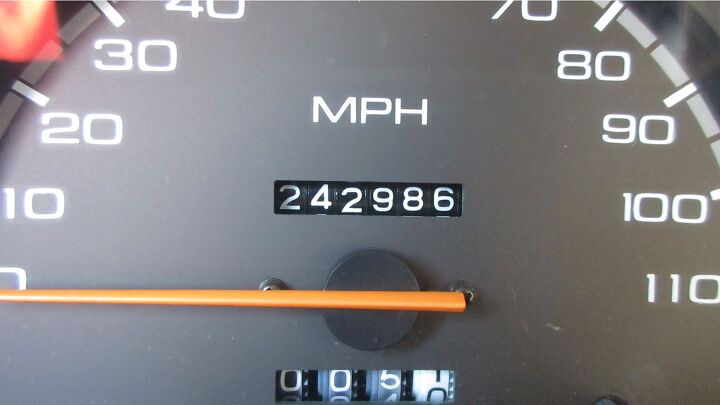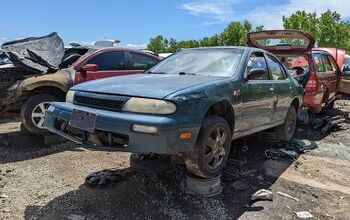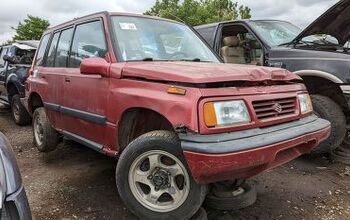448 Views
Junkyard Find: 1993 Isuzu Amigo

by
Murilee Martin
(IC: employee)
Published: December 18th, 2017
Share
The family tree of the Isuzu Faster pickup, best known in North America as the Chevrolet LUV, developed a thick branch of models that included some decent-selling SUVs. The two-door Amigo was the first of these to hit our shores.Here’s a high-mile example spotted in a San Francisco Bay Area self-service wrecking yard.
This Amigo is a rear-wheel-drive model with five-speed manual and air conditioning. Its California smog-check records show passed biennial emissions tests going back to the middle 1990s, so it appears to have been a reliable commuter machine, racking up more than 10,000 Golden State highway miles each year.
The Amigo’s four-door big brother, the Rodeo, could be had with a GM 3.1-liter V6 in 1993, but Amigo drivers had to accept the 119-horse, 2.6-liter straight-four.
It’s vaguely outdoorsy-looking, but it’s likely nearly all of its miles were spent in stop-and-go traffic on the deteriorating tarmac of California’s roads. Part of the reason for the death of the manual transmission in the American market is the preference for as little left-leg activity as possible during an 11-mile/90-minute commute, but the driver(s) of this car lived with the five-speed. In any case, the Amigo had a sportier image than, say, a 1993 Honda Del Sol, and perhaps that eased the pain of those hundreds of thousands of 0.75 mph clutch applications.
The interior and cloth top are in pretty good condition, indicating that this Amigo’s owner or owners garaged it for most of its life. I didn’t see any major crash damage, so an expensive mechanical failure is the likely culprit that doomed this truck.
{
"id": "9199827",
"alt": "",
"title": "",
"video_link": "https://www.youtube.com/embed/bRnT-TklALk",
"youtube_video_id": "bRnT-TklALk"
}
{
"width": 634,
"height": 357,
"showRelated": true
}
The first-generation Amigo was sold in the United States for the 1989 through 1995 model years (it returned in 1998), and this retro commercial riffs on the brain-scrambling Slinky ads of two decades earlier.
#1990s
#1993
#1993IsuzuAmigo
#Amigo
#California
#DownOnTheJunkyard
#Isuzu
#IsuzuAmigo
#IsuzuMU
#IsuzuRodeo
#Junkyard
#JunkyardFind
#Rodeo

Murilee Martin
Murilee Martin is the pen name of Phil Greden, a writer who has lived in Minnesota, California, Georgia and (now) Colorado. He has toiled at copywriting, technical writing, junkmail writing, fiction writing and now automotive writing. He has owned many terrible vehicles and some good ones. He spends a great deal of time in self-service junkyards. These days, he writes for publications including Autoweek, Autoblog, Hagerty, The Truth About Cars and Capital One.
More by Murilee Martin
Published December 18th, 2017 8:00 AM
Latest Car Reviews
Read moreLatest Product Reviews
Read moreRecent Comments
- Funky D There are WAY too many of what my youngest son calls grayscale (white, black, silver, gray) out there.I will pick literally ANY color (including that baby puke yellow found on new Chevy crossovers) over a grayscale color. But if every car I had was arrest-me red, I'd be find with that.What happened to the 60s~80s when you could choose from a pretty rich color palate when placing your new car order?
- Tassos Jeep again proving they stand behind freedom. The freedom to choose the fuel you use. I’ll take one in ”Right to express myself freely” pink.
- Jeff Good move on Cadillac's part. Not everyone is ready for an EV it will take more time to expand the charging infrastructure and more affordable EVs.
- 3-On-The-Tree I was never a fan of the newer dodge products but it’s still a shame that all the OEM’s are moving away from V8’s to turbo V6 and V4’s all in the name of emissions and better mpg.
- FreedMike I like the idea of EVs, but the idea that they're going to achieve 100% market penetration was a fantasy to begin with. Also worth noting; Cadillac is on track to sell well over 20,000 Lyriqs this year. Not too shabby. https://www.coxautoinc.com/wp-content/uploads/2024/04/Q1-2024-Kelley-Blue-Book-Electric-Vehicle-Sales-Report.pdf

















































Comments
Join the conversation
A 2.6 liter 4 with 119 horsepower in a vehicle from 1993 sounds like a complete dog, to be honest...
Out of curiosity: Is it normal for an owner to not remove the plates on a vehicle destined for a wrecking yard? I was surprised to see the front plate on the passenger seat and the rear plate looking as though it was "ripped" off the rear (instead of just removing the mounting screws holding it on). We get a credit if we turn in plates from a vehicle that is being disposed of in this manner (or at least we used to).